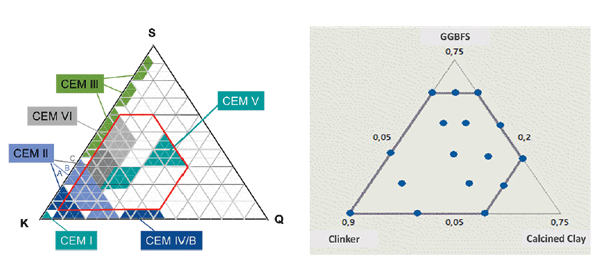Strength development of ternary cements
Low-clinker ternary cements containing clinker, blastfurnace slag and calcined clay are becoming increasingly important in cement markets where decarbonisation is the key to sustainable construction. Central to the production of concrete for these construction projects is the strength development of ternary cements, which is the focus of a recent research project by VDZ. By Simone Elisabeth Schulze and Joerg Rickert, VDZ Technology GmbH, Germany.

Figure 1: area of investigated cement compositions according to EN 197-1 and EN 197-5 (left);
mixture design of DoE, realised cement compositions are marked with blue dots (right)
In view of the challenge of decarbonisation of the cement and concrete industry, the use of low-clinker ternary cements, especially with calcined clay, is becoming increasingly important.1 Cements containing calcined clays will have to be addressed in cement standards around the world. According to European standard EN 197-1,2 calcined clays can be used in eight different types of cement. Additionally, the new EN 197-53 specifies the composition of further low-clinker cements. Accordingly, calcined clays can be used in CEM II/C-M cements. However, due to a lack of experience, ternary cements with calcined clay and ground granulated blastfurnace slag (GGBS) as main constituents (CEM VI) have not yet found their way into the new EN 197-5 standard, although this combination in particular is very promising in terms of cement properties and concrete performance as well as CO2-savings potential.

